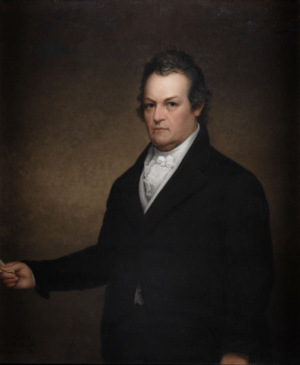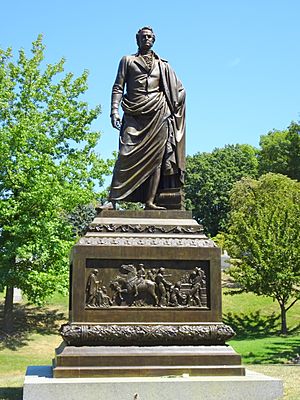DeWitt Clinton facts for kids
DeWitt Clinton (born March 2, 1769 – died February 11, 1828) was an important American politician. He served as a United States senator, was the mayor of New York City, and became the sixth governor of New York. He is most famous for leading the building of the Erie Canal, a huge waterway that changed New York and the United States. In 1812, he ran for president against James Madison.
DeWitt Clinton was the nephew of George Clinton, who was a U.S. vice president and New York governor. DeWitt started his career as his uncle's secretary. He joined the Democratic-Republican Party and was elected to the New York State Legislature. He also briefly served as a U.S. Senator. Later, he was appointed Mayor of New York City three times and also served as the Lieutenant Governor of New York State. In the 1812 presidential election, he gained support from the Federalist Party and some Democratic-Republicans. Even though James Madison won, Clinton did very well, especially in the Northeastern United States. After this election, he remained a member of the Democratic-Republican Party.
Clinton was governor of New York from 1817 to 1822 and again from 1825 to 1828. During his time as governor, he oversaw the building of the Erie Canal. He believed that improving things like roads and canals could make American life better, help the economy grow, and encourage people to get involved in politics. He had a big impact on how New York State and the whole country developed their transportation systems.
Quick facts for kids
DeWitt Clinton
|
|
|---|---|

Portrait of DeWitt Clinton by Rembrandt Peale, 1823
|
|
| 6th Governor of New York | |
| In office January 1, 1825 – February 11, 1828 |
|
| Lieutenant | James Tallmadge Jr. Nathaniel Pitcher |
| Preceded by | Joseph C. Yates |
| Succeeded by | Nathaniel Pitcher |
| In office July 1, 1817 – January 1, 1823 |
|
| Lieutenant | John Tayler |
| Preceded by | John Tayler (acting) |
| Succeeded by | Joseph C. Yates |
| 47th, 49th and 51st Mayor of New York City | |
| In office 1811–1815 |
|
| Preceded by | Jacob Radcliff |
| Succeeded by | John Ferguson |
| In office 1808–1810 |
|
| Preceded by | Marinus Willett |
| Succeeded by | Jacob Radcliff |
| In office 1803–1807 |
|
| Preceded by | Edward Livingston |
| Succeeded by | Marinus Willett |
| Lieutenant Governor of New York | |
| In office 1811–1813 |
|
| Governor | Daniel D. Tompkins |
| Preceded by | John Tayler (acting) |
| Succeeded by | John Tayler |
| United States Senator from New York |
|
| In office February 9, 1802 – November 4, 1803 |
|
| Preceded by | John Armstrong Jr. |
| Succeeded by | John Armstrong Jr. |
| Personal details | |
| Born | March 2, 1769 Little Britain, New York, British America |
| Died | February 11, 1828 (aged 58) Albany, New York, U.S. |
| Political party | Democratic-Republican |
| Other political affiliations |
Federalist (1812) |
| Spouses |
Maria Franklin
(m. 1796; died 1818)Catharine Jones
(m. 1819) |
| Children | 10, including George W. Clinton |
| Education | Princeton University Columbia University (BA) |
| Signature | |
Contents
Early Life and Education
DeWitt Clinton was born on March 2, 1769, in Little Britain, New York. His father was Major-General James Clinton, and his mother was Mary De Witt. His mother's family, the De Witts, were important Dutch people.
He went to Kingston Academy and then studied at the College of New Jersey (now Princeton University). He later transferred to King's College, which changed its name to Columbia College while he was a student there. He was part of the first class to graduate under the new name.
After college, he became the secretary for his uncle, George Clinton, who was the governor of New York at the time. Soon after, DeWitt Clinton joined the Democratic-Republican Party.
Political Career
Starting in Politics
Clinton began his political career in the New York State Assembly in 1798. He then served in the New York State Senate from 1798 to 1802 and again from 1806 to 1811. He also helped write the New York State Constitution in 1801.
In 1801, his uncle, Governor George Clinton, put him in charge of the Council of Appointments. This group had the power to choose thousands of people for government jobs, including sheriffs and the mayor of New York City. DeWitt Clinton used this power to become a very influential politician in New York.
In 1802, he was chosen by the New York State legislature to be a U.S. Senator for New York. He served from February 1802 to November 1803. He resigned because he was not happy with living in the new city of Washington, D.C. After leaving the Senate, he was appointed mayor of New York City.
Mayor of New York City
Clinton served as mayor of New York City for three different periods: from 1803 to 1807, 1808 to 1810, and 1811 to 1815. During his time as mayor, he helped create the New-York Historical Society in 1804. He was also a key leader in starting the Erie Canal project. He helped reorganize the American Academy of the Fine Arts and was its president. He was also a regent for the University of the State of New York.
Lieutenant Governor
In 1811, there was an open spot for the Lieutenant Governor of New York. Clinton won a special election to fill this role. He served as lieutenant governor until June 1813.
Running for President
In 1812, DeWitt Clinton ran for president. He was supported by the Federalist Party and some members of the Democratic-Republican Party who disagreed with the current president, James Madison. In a very close election, Clinton lost to President Madison. Clinton received 89 electoral votes, while Madison received 128. This was the strongest showing for any Federalist-backed candidate since 1800. If only a few votes had changed in one or two states, Clinton could have won.
Governor of New York
After Daniel D. Tompkins resigned as governor, Clinton won a special election in 1817. He was the only main candidate and took office on July 1, 1817. He was re-elected in 1820, winning a close race against Vice President Tompkins. He served as governor until December 31, 1822.
During his second term, the rules for the governor's term changed, making it shorter. In 1824, many of his political rivals tried to remove him from the Erie Canal Commission. This made many voters angry, and as a result, Clinton was nominated for governor by a new group called the People's Party. He was re-elected governor, beating the official candidate of the Democratic-Republican Party. He served two more terms until he passed away suddenly while still in office.
Freemasonry
DeWitt Clinton was a Freemason, which is a fraternal organization. He became a member in 1790 and was elected Grand Master of the Grand Lodge of New York in 1806. He also helped create the Grand Encampment of Knights Templar in the United States and was its first leader from 1816 until his death in 1828.
In 1826, an event called the William Morgan Affair happened. A man named William Morgan disappeared after threatening to reveal secrets about Freemasonry. Many believed he was kidnapped and murdered by Masons. Governor Clinton offered a reward for information about what happened, but it did not lead to answers. This event caused a lot of criticism of Freemasonry in the United States.
The Grand Lodge of New York created the DeWitt Clinton Award to recognize people or groups who do great community service.
Building the Erie Canal
From 1810 to 1824, Clinton was a member of the Erie Canal Commission. This group planned the route for the canal.
As governor, Clinton was largely responsible for the building of the Erie Canal. He was convinced by Jesse Hawley to support building a canal from Lake Erie to the Hudson River. Many people thought this project was impossible and called it "Clinton's Folly" or "DeWitt's Ditch." But in 1817, he convinced the state legislature to approve $7 million for its construction. This amount would be about $168 million today.
When the canal was finished in 1825, Clinton officially opened it. He traveled by boat along the canal to Buffalo. After riding from Lake Erie to New York City, he poured two barrels of water from Lake Erie into New York Harbor. This celebrated the first time waters from the Great Lakes were connected to the Atlantic Ocean.
The canal was a huge success! It carried many passengers and a lot of goods. The cost of moving goods between Buffalo and Albany dropped from $100 to just $10 per ton. The state quickly earned back the money it spent by collecting tolls on the canal. After the canal was completed, public opinion about Clinton changed. He was now praised for his great achievement. Newspapers that had criticized him before now celebrated his success.
Personal Life
DeWitt Clinton was married twice. In 1796, he married Maria Franklin. They had ten children together, and seven of them were still alive when she passed away in 1818. One of their sons was George William Clinton, who later became the mayor of Buffalo, New York.
In 1819, Clinton married Catharine Jones. She was the daughter of a New York doctor. Catharine lived longer than her husband.
DeWitt Clinton passed away suddenly from heart failure in Albany, New York, on February 11, 1828. He left his family in a difficult financial situation. Even though he was a great leader in government, he did not manage his own money well. His family was in debt and had no money after he died. His belongings were sold to pay off his debts.
He had a grand state funeral, but his family could not afford a burial plot. So, his body was placed in the family vault of a friend in Albany. Sixteen years later, enough money was collected to provide a proper burial. On June 21, 1844, his remains were moved to Green-Wood Cemetery in Brooklyn, New York.
Legacy and Impact
DeWitt Clinton's achievements as a leader included improving New York's public school system. He also supported steam navigation and changed laws for criminals and people in debt. A famous early train, the 1831 DeWitt Clinton locomotive, was named after him.
Many places are named after DeWitt Clinton:
- A $1,000 bill from 1880 featured his portrait.
- Clinton County, Iowa, and the city of Clinton, Iowa, are named for him.
- Illinois has two counties named after him: Clinton County and DeWitt County. The city of Clinton, Illinois, is in DeWitt County.
- Columbia University established the DeWitt Clinton Professorship of American History in 1926.
- The Erie Canal's 200th anniversary celebrations, which started in 2017, have brought more attention to DeWitt Clinton's role.
- The city of DeWitt, Michigan, is named for Clinton.
- The town and township of Clinton, New Jersey, are named after him.
- The township of Clinton, Indiana, is named after him.
- The city of Clinton, Louisiana, founded in 1824, is named after him.
- A type of flowering plant, Clintonia, was named in his honor in 1818.
His portrait also appeared on many tobacco tax stamps in the late 1800s and early 1900s.
See also
 In Spanish: DeWitt Clinton para niños
In Spanish: DeWitt Clinton para niños




